Analysis of the Australian Economic Slowdown and Banking Sector
VerifiedAdded on 2022/08/22
|8
|893
|16
Report
AI Summary
This report examines the economic slowdown in Australia, emphasizing its effects on the banking sector. It identifies key factors contributing to the downturn, such as failures in the real estate and construction industries, risky lending practices, and the dependence of major banks on home lending and overseas finances. The analysis highlights the impacts of the slowdown, including rising interest rates, reduced home loans, and decreased competition, as well as the potential effects on the mining and automobile industries. The report suggests several mitigation strategies, including policy adjustments, emergency bank funding, strengthening the mortgage market, structural changes in bank funding costs, and maintaining sufficient net interest margins and bank profitability. The conclusion emphasizes that the Australian banking sector, though well-capitalized, needs policy modifications to navigate the economic challenges effectively.
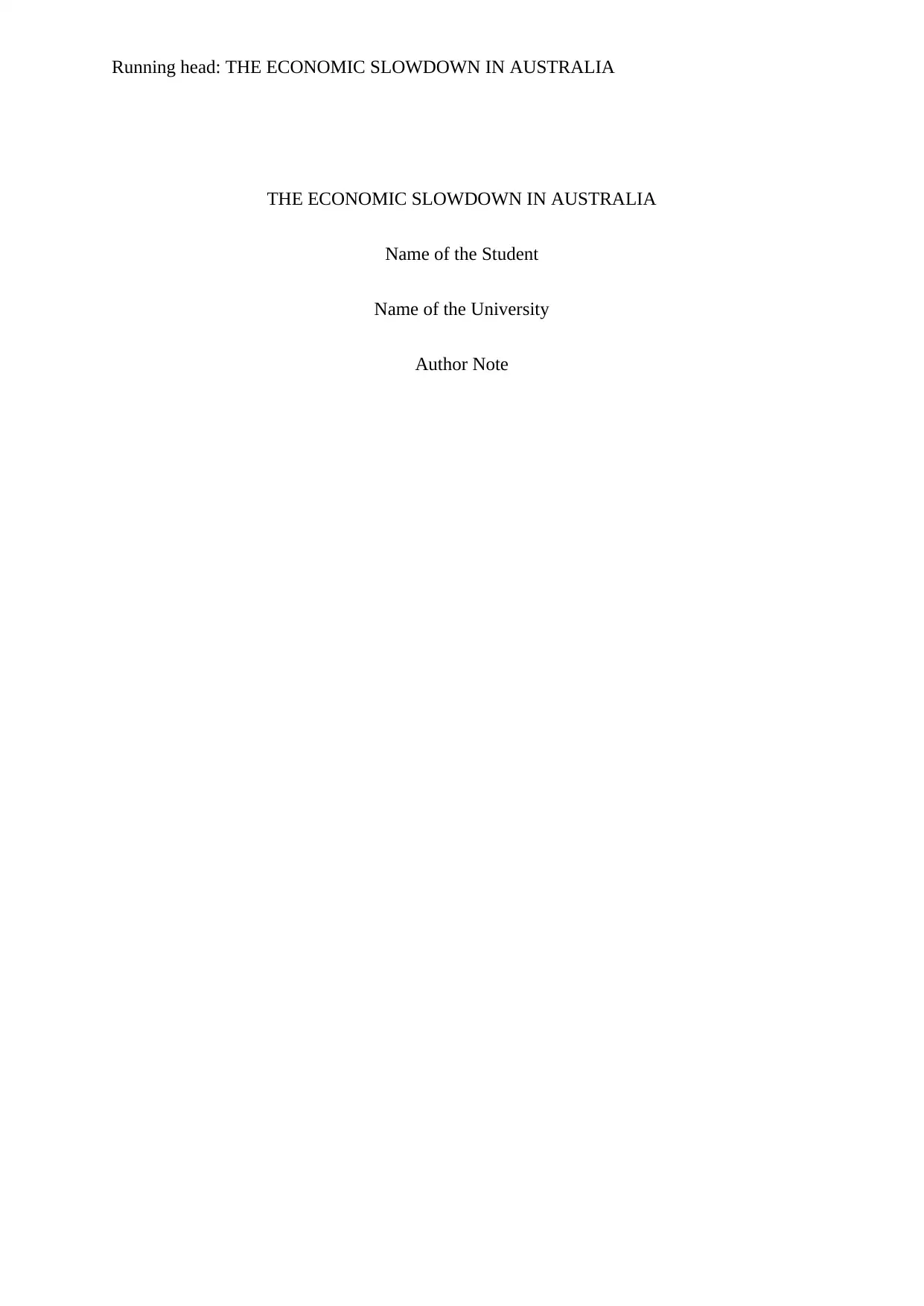
Running head: THE ECONOMIC SLOWDOWN IN AUSTRALIA
THE ECONOMIC SLOWDOWN IN AUSTRALIA
Name of the Student
Name of the University
Author Note
THE ECONOMIC SLOWDOWN IN AUSTRALIA
Name of the Student
Name of the University
Author Note
Paraphrase This Document
Need a fresh take? Get an instant paraphrase of this document with our AI Paraphraser
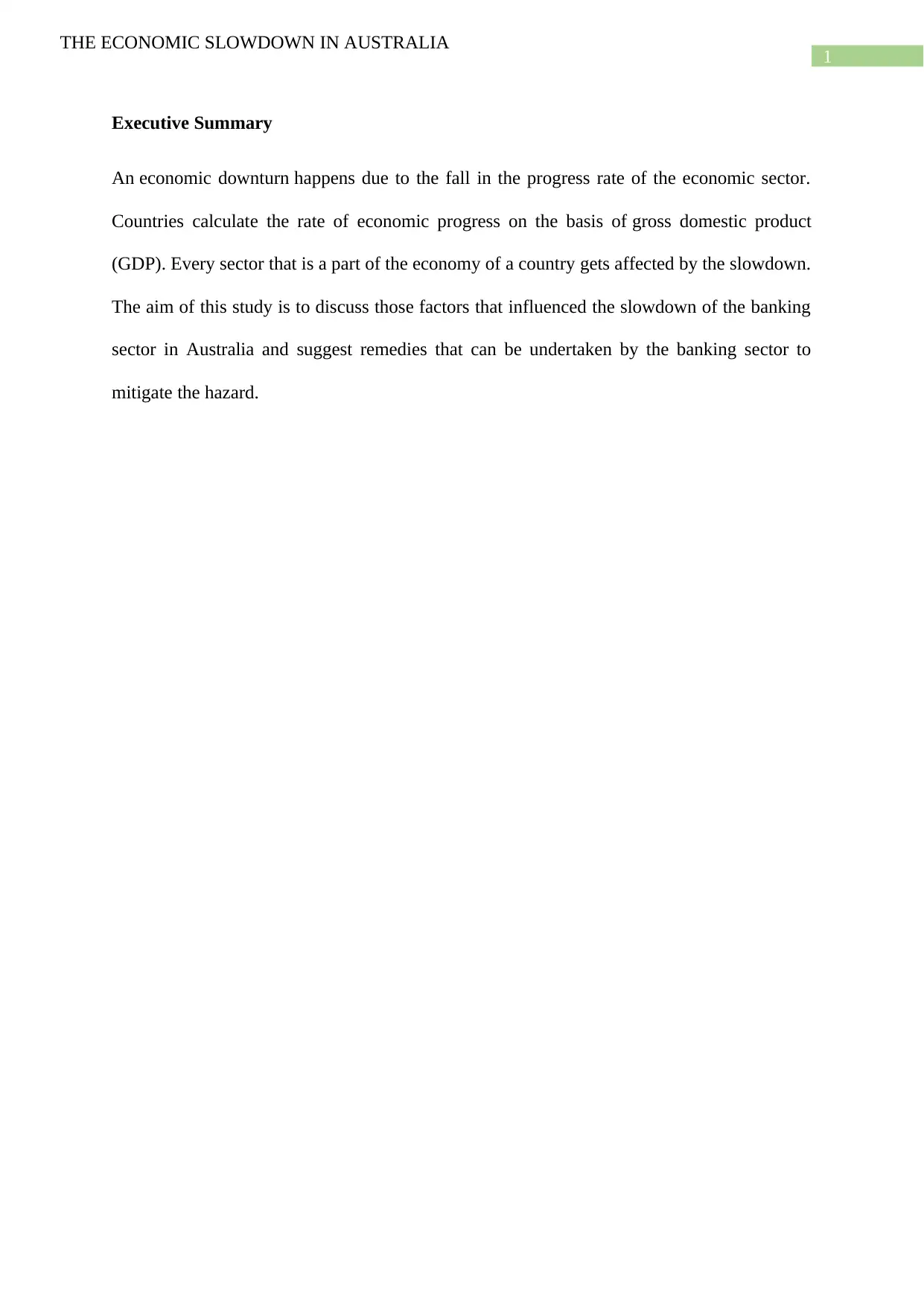
1
THE ECONOMIC SLOWDOWN IN AUSTRALIA
Executive Summary
An economic downturn happens due to the fall in the progress rate of the economic sector.
Countries calculate the rate of economic progress on the basis of gross domestic product
(GDP). Every sector that is a part of the economy of a country gets affected by the slowdown.
The aim of this study is to discuss those factors that influenced the slowdown of the banking
sector in Australia and suggest remedies that can be undertaken by the banking sector to
mitigate the hazard.
THE ECONOMIC SLOWDOWN IN AUSTRALIA
Executive Summary
An economic downturn happens due to the fall in the progress rate of the economic sector.
Countries calculate the rate of economic progress on the basis of gross domestic product
(GDP). Every sector that is a part of the economy of a country gets affected by the slowdown.
The aim of this study is to discuss those factors that influenced the slowdown of the banking
sector in Australia and suggest remedies that can be undertaken by the banking sector to
mitigate the hazard.
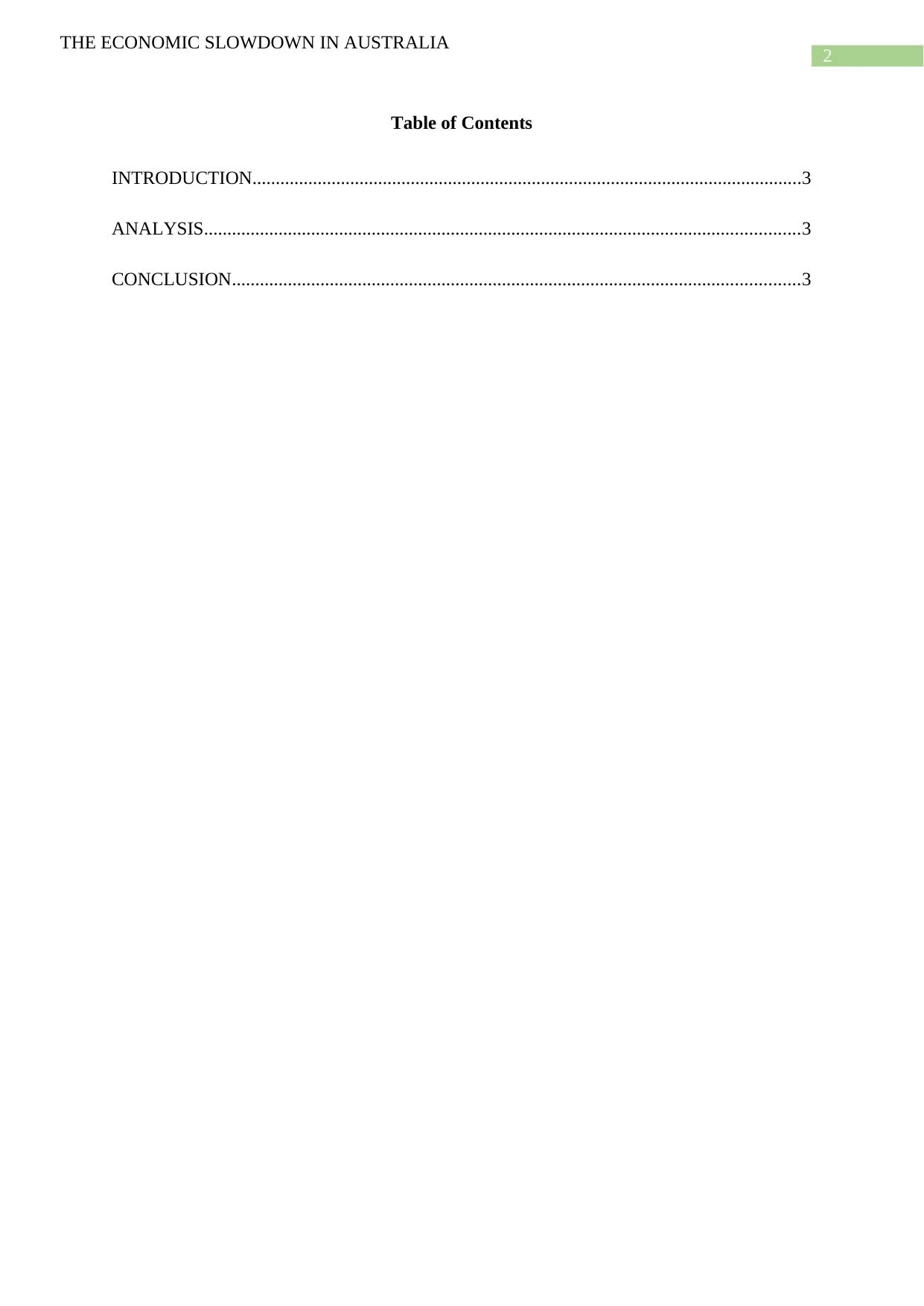
2
THE ECONOMIC SLOWDOWN IN AUSTRALIA
Table of Contents
INTRODUCTION......................................................................................................................3
ANALYSIS................................................................................................................................3
CONCLUSION..........................................................................................................................3
THE ECONOMIC SLOWDOWN IN AUSTRALIA
Table of Contents
INTRODUCTION......................................................................................................................3
ANALYSIS................................................................................................................................3
CONCLUSION..........................................................................................................................3
⊘ This is a preview!⊘
Do you want full access?
Subscribe today to unlock all pages.

Trusted by 1+ million students worldwide
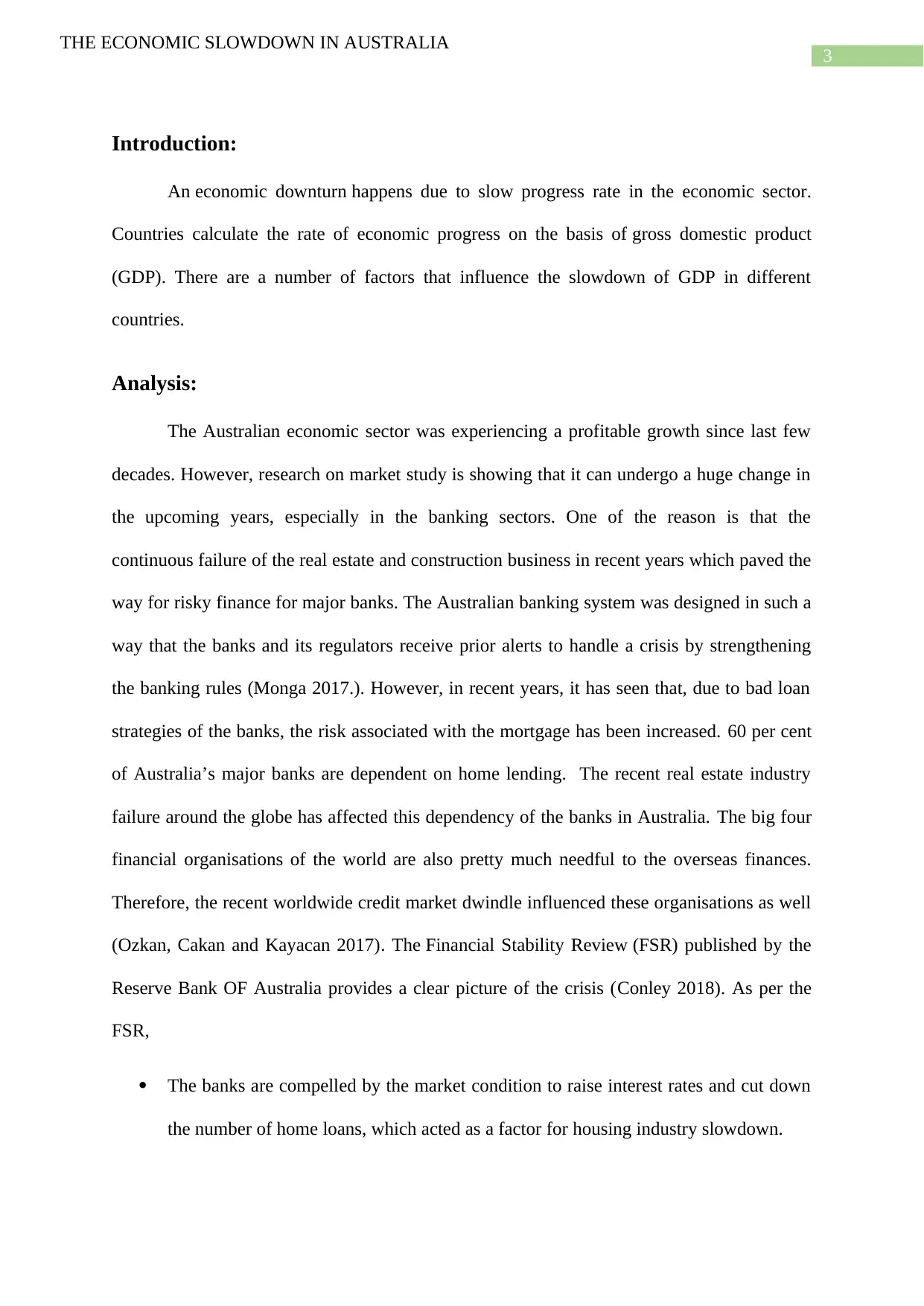
3
THE ECONOMIC SLOWDOWN IN AUSTRALIA
Introduction:
An economic downturn happens due to slow progress rate in the economic sector.
Countries calculate the rate of economic progress on the basis of gross domestic product
(GDP). There are a number of factors that influence the slowdown of GDP in different
countries.
Analysis:
The Australian economic sector was experiencing a profitable growth since last few
decades. However, research on market study is showing that it can undergo a huge change in
the upcoming years, especially in the banking sectors. One of the reason is that the
continuous failure of the real estate and construction business in recent years which paved the
way for risky finance for major banks. The Australian banking system was designed in such a
way that the banks and its regulators receive prior alerts to handle a crisis by strengthening
the banking rules (Monga 2017.). However, in recent years, it has seen that, due to bad loan
strategies of the banks, the risk associated with the mortgage has been increased. 60 per cent
of Australia’s major banks are dependent on home lending. The recent real estate industry
failure around the globe has affected this dependency of the banks in Australia. The big four
financial organisations of the world are also pretty much needful to the overseas finances.
Therefore, the recent worldwide credit market dwindle influenced these organisations as well
(Ozkan, Cakan and Kayacan 2017). The Financial Stability Review (FSR) published by the
Reserve Bank OF Australia provides a clear picture of the crisis (Conley 2018). As per the
FSR,
The banks are compelled by the market condition to raise interest rates and cut down
the number of home loans, which acted as a factor for housing industry slowdown.
THE ECONOMIC SLOWDOWN IN AUSTRALIA
Introduction:
An economic downturn happens due to slow progress rate in the economic sector.
Countries calculate the rate of economic progress on the basis of gross domestic product
(GDP). There are a number of factors that influence the slowdown of GDP in different
countries.
Analysis:
The Australian economic sector was experiencing a profitable growth since last few
decades. However, research on market study is showing that it can undergo a huge change in
the upcoming years, especially in the banking sectors. One of the reason is that the
continuous failure of the real estate and construction business in recent years which paved the
way for risky finance for major banks. The Australian banking system was designed in such a
way that the banks and its regulators receive prior alerts to handle a crisis by strengthening
the banking rules (Monga 2017.). However, in recent years, it has seen that, due to bad loan
strategies of the banks, the risk associated with the mortgage has been increased. 60 per cent
of Australia’s major banks are dependent on home lending. The recent real estate industry
failure around the globe has affected this dependency of the banks in Australia. The big four
financial organisations of the world are also pretty much needful to the overseas finances.
Therefore, the recent worldwide credit market dwindle influenced these organisations as well
(Ozkan, Cakan and Kayacan 2017). The Financial Stability Review (FSR) published by the
Reserve Bank OF Australia provides a clear picture of the crisis (Conley 2018). As per the
FSR,
The banks are compelled by the market condition to raise interest rates and cut down
the number of home loans, which acted as a factor for housing industry slowdown.
Paraphrase This Document
Need a fresh take? Get an instant paraphrase of this document with our AI Paraphraser
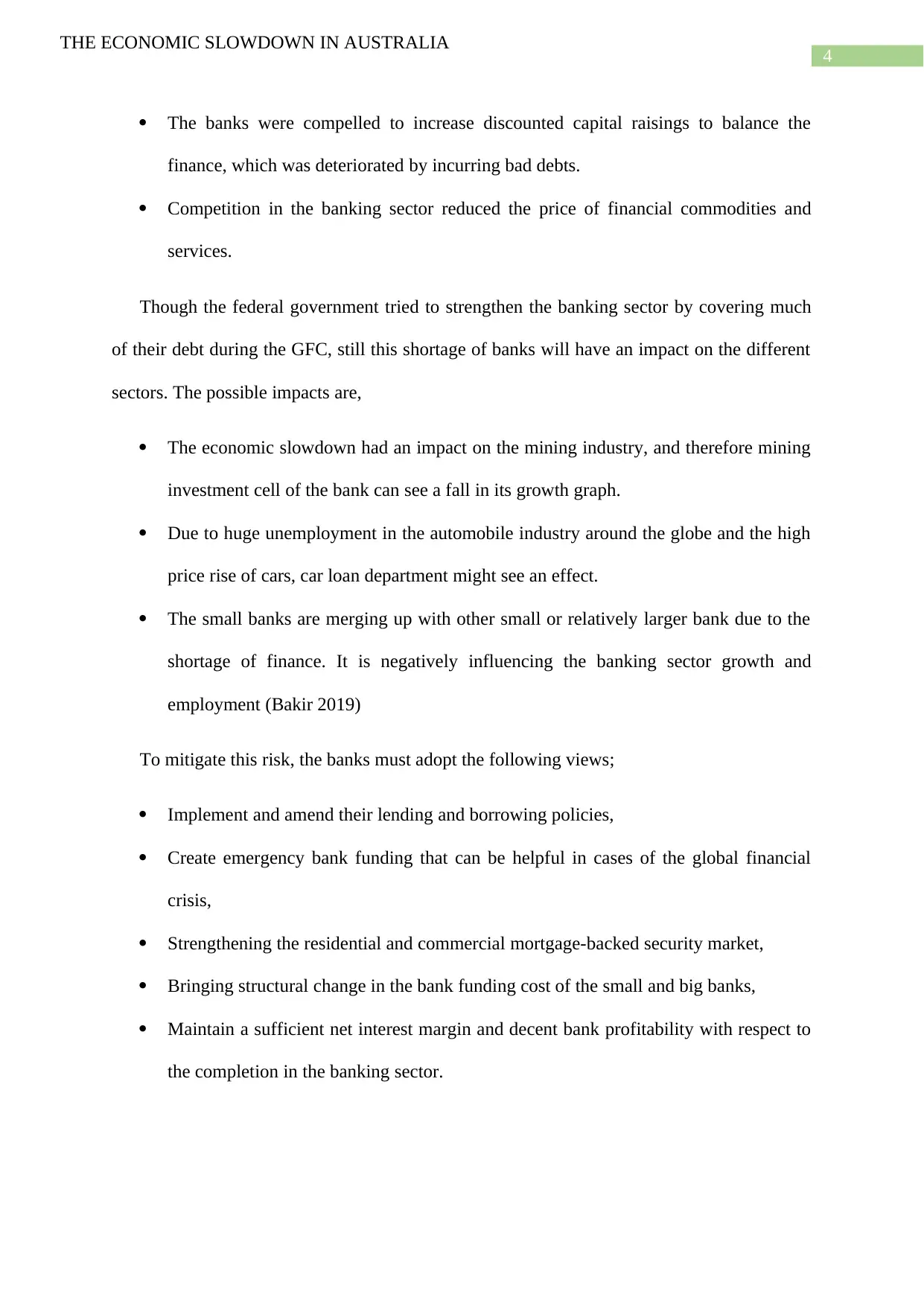
4
THE ECONOMIC SLOWDOWN IN AUSTRALIA
The banks were compelled to increase discounted capital raisings to balance the
finance, which was deteriorated by incurring bad debts.
Competition in the banking sector reduced the price of financial commodities and
services.
Though the federal government tried to strengthen the banking sector by covering much
of their debt during the GFC, still this shortage of banks will have an impact on the different
sectors. The possible impacts are,
The economic slowdown had an impact on the mining industry, and therefore mining
investment cell of the bank can see a fall in its growth graph.
Due to huge unemployment in the automobile industry around the globe and the high
price rise of cars, car loan department might see an effect.
The small banks are merging up with other small or relatively larger bank due to the
shortage of finance. It is negatively influencing the banking sector growth and
employment (Bakir 2019)
To mitigate this risk, the banks must adopt the following views;
Implement and amend their lending and borrowing policies,
Create emergency bank funding that can be helpful in cases of the global financial
crisis,
Strengthening the residential and commercial mortgage-backed security market,
Bringing structural change in the bank funding cost of the small and big banks,
Maintain a sufficient net interest margin and decent bank profitability with respect to
the completion in the banking sector.
THE ECONOMIC SLOWDOWN IN AUSTRALIA
The banks were compelled to increase discounted capital raisings to balance the
finance, which was deteriorated by incurring bad debts.
Competition in the banking sector reduced the price of financial commodities and
services.
Though the federal government tried to strengthen the banking sector by covering much
of their debt during the GFC, still this shortage of banks will have an impact on the different
sectors. The possible impacts are,
The economic slowdown had an impact on the mining industry, and therefore mining
investment cell of the bank can see a fall in its growth graph.
Due to huge unemployment in the automobile industry around the globe and the high
price rise of cars, car loan department might see an effect.
The small banks are merging up with other small or relatively larger bank due to the
shortage of finance. It is negatively influencing the banking sector growth and
employment (Bakir 2019)
To mitigate this risk, the banks must adopt the following views;
Implement and amend their lending and borrowing policies,
Create emergency bank funding that can be helpful in cases of the global financial
crisis,
Strengthening the residential and commercial mortgage-backed security market,
Bringing structural change in the bank funding cost of the small and big banks,
Maintain a sufficient net interest margin and decent bank profitability with respect to
the completion in the banking sector.
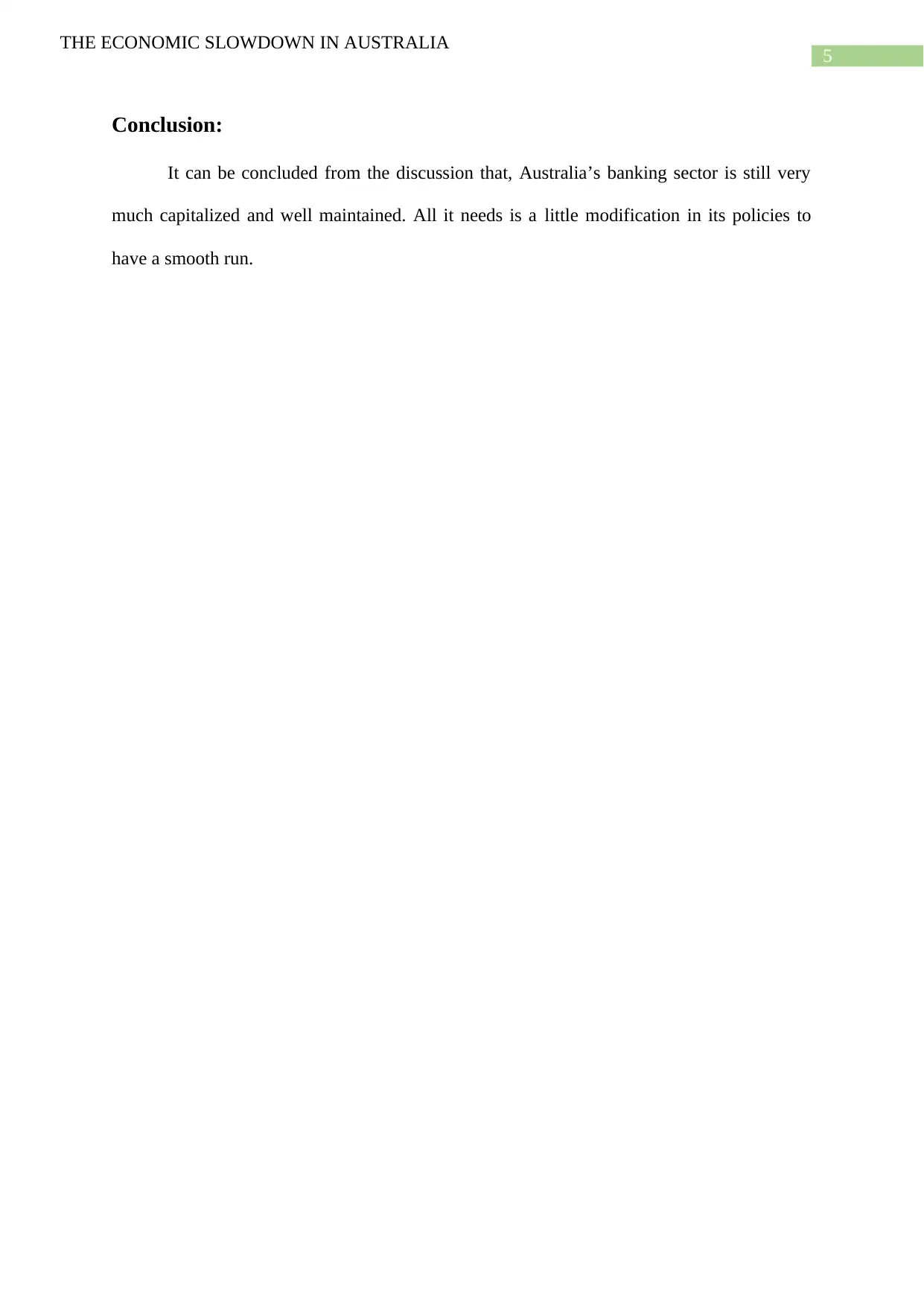
5
THE ECONOMIC SLOWDOWN IN AUSTRALIA
Conclusion:
It can be concluded from the discussion that, Australia’s banking sector is still very
much capitalized and well maintained. All it needs is a little modification in its policies to
have a smooth run.
THE ECONOMIC SLOWDOWN IN AUSTRALIA
Conclusion:
It can be concluded from the discussion that, Australia’s banking sector is still very
much capitalized and well maintained. All it needs is a little modification in its policies to
have a smooth run.
⊘ This is a preview!⊘
Do you want full access?
Subscribe today to unlock all pages.

Trusted by 1+ million students worldwide
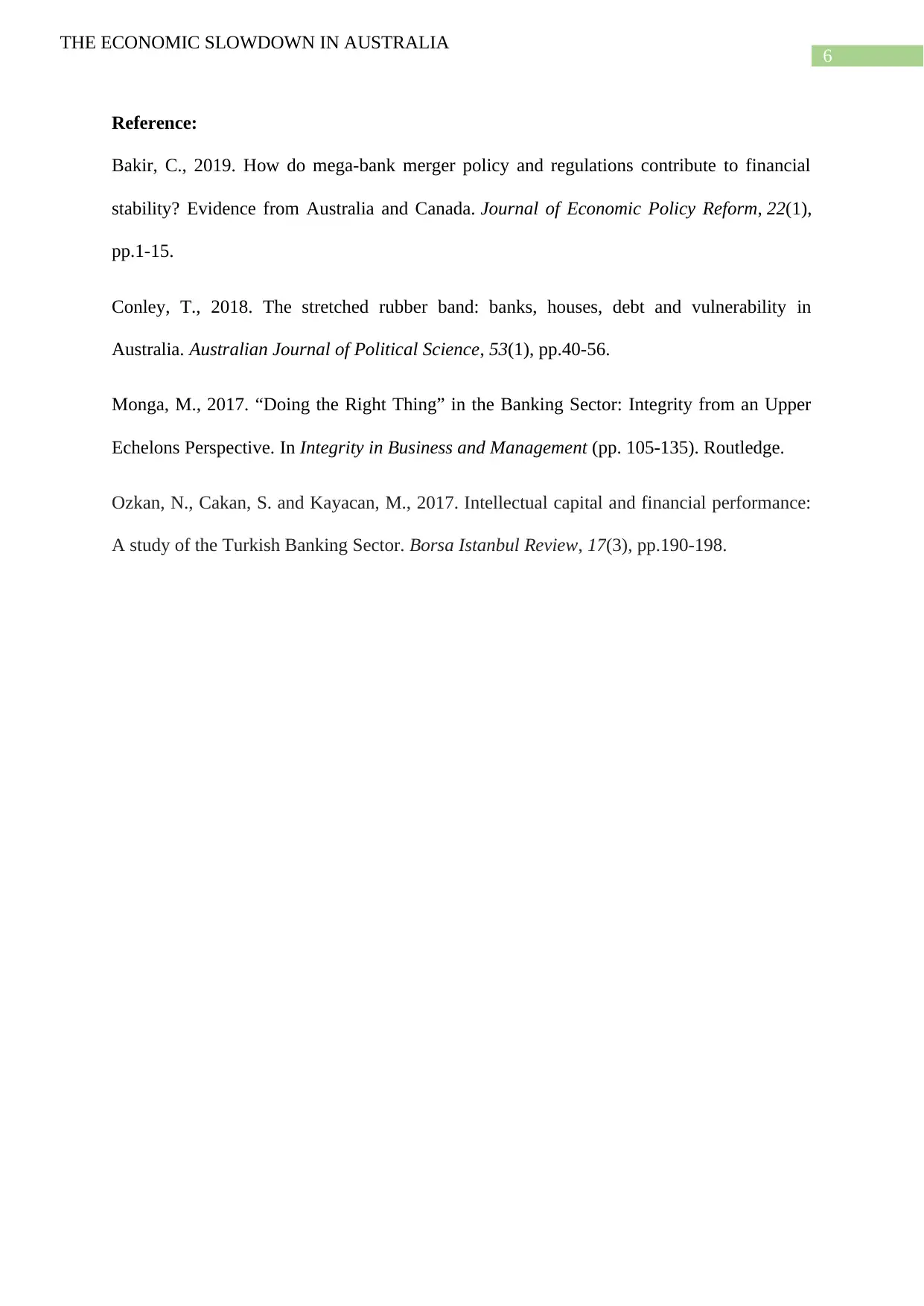
6
THE ECONOMIC SLOWDOWN IN AUSTRALIA
Reference:
Bakir, C., 2019. How do mega-bank merger policy and regulations contribute to financial
stability? Evidence from Australia and Canada. Journal of Economic Policy Reform, 22(1),
pp.1-15.
Conley, T., 2018. The stretched rubber band: banks, houses, debt and vulnerability in
Australia. Australian Journal of Political Science, 53(1), pp.40-56.
Monga, M., 2017. “Doing the Right Thing” in the Banking Sector: Integrity from an Upper
Echelons Perspective. In Integrity in Business and Management (pp. 105-135). Routledge.
Ozkan, N., Cakan, S. and Kayacan, M., 2017. Intellectual capital and financial performance:
A study of the Turkish Banking Sector. Borsa Istanbul Review, 17(3), pp.190-198.
THE ECONOMIC SLOWDOWN IN AUSTRALIA
Reference:
Bakir, C., 2019. How do mega-bank merger policy and regulations contribute to financial
stability? Evidence from Australia and Canada. Journal of Economic Policy Reform, 22(1),
pp.1-15.
Conley, T., 2018. The stretched rubber band: banks, houses, debt and vulnerability in
Australia. Australian Journal of Political Science, 53(1), pp.40-56.
Monga, M., 2017. “Doing the Right Thing” in the Banking Sector: Integrity from an Upper
Echelons Perspective. In Integrity in Business and Management (pp. 105-135). Routledge.
Ozkan, N., Cakan, S. and Kayacan, M., 2017. Intellectual capital and financial performance:
A study of the Turkish Banking Sector. Borsa Istanbul Review, 17(3), pp.190-198.
Paraphrase This Document
Need a fresh take? Get an instant paraphrase of this document with our AI Paraphraser
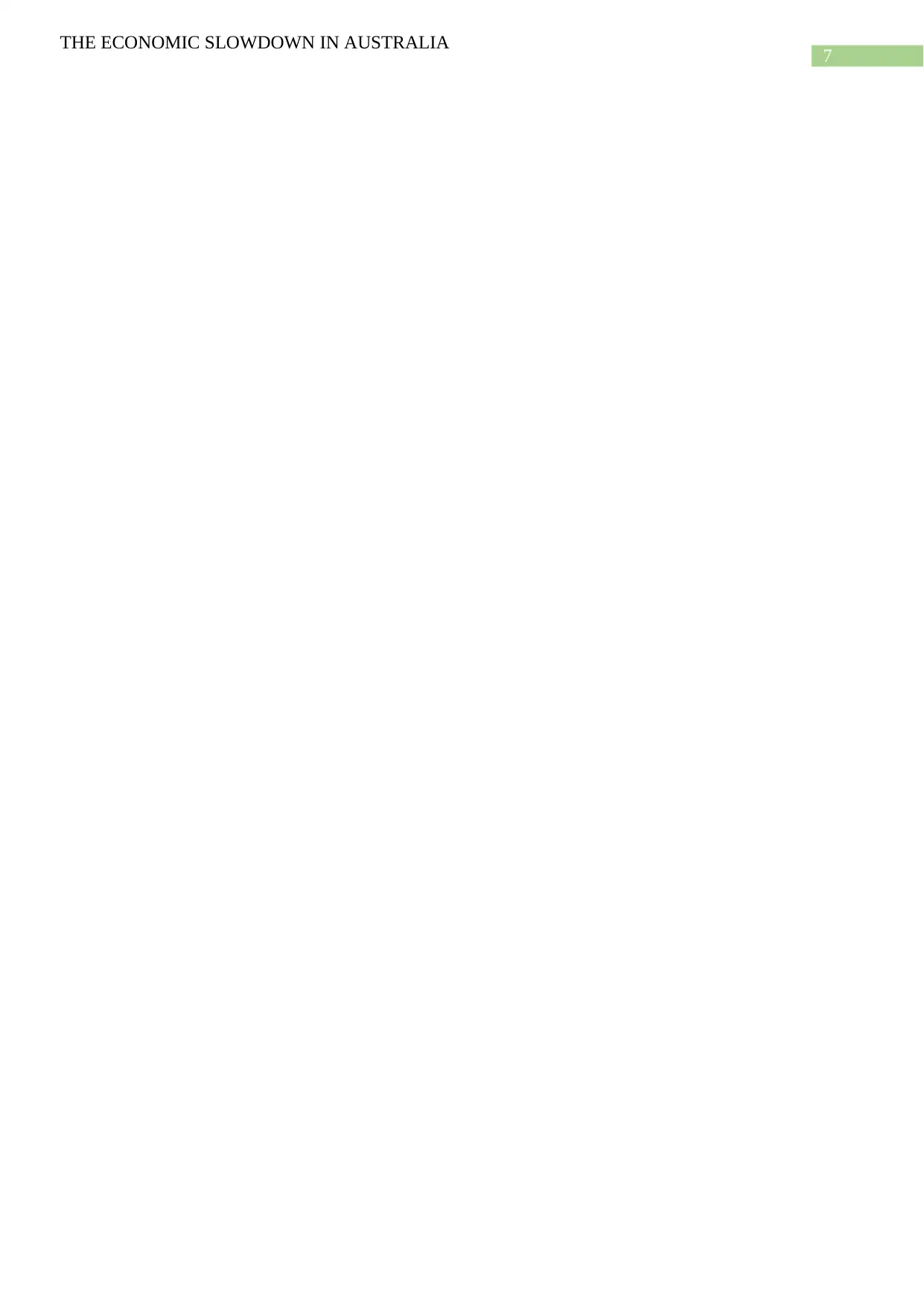
7
THE ECONOMIC SLOWDOWN IN AUSTRALIA
THE ECONOMIC SLOWDOWN IN AUSTRALIA
1 out of 8
Related Documents
Your All-in-One AI-Powered Toolkit for Academic Success.
+13062052269
info@desklib.com
Available 24*7 on WhatsApp / Email
![[object Object]](/_next/static/media/star-bottom.7253800d.svg)
Unlock your academic potential
Copyright © 2020–2025 A2Z Services. All Rights Reserved. Developed and managed by ZUCOL.




